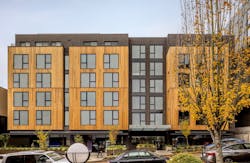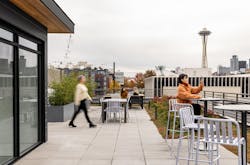7 things to know about designing for Chinese multifamily developers
Chinese multifamily and mixed-use developers, property owners, and investors have become more active in the U.S. over the past two decades, prompting architects to consider the unique cultural differences in the way we work and how we design apartment and condominium projects for these clients.
At Johnston Architects, I have had the opportunity to share my understanding of these nuances, enabling the firm to develop more successful, deeper relationships with our Chinese clients. Many of the differences are related to a different understanding of roles and the structure of the relationship, while others are based in tradition.
Here are seven insights that are rooted in cultural knowledge for fostering a trusting and prosperous relationship with Chinese clients.
1. In China, the developer is almost always both the visionary and the executive of the project. All land in China is publicly owned but can be leased for long-term private use, so developers propose their visions to the jurisdiction officials to “acquire” land use opportunities. Successful visions are often keyed to factors like job creation, population growth, and urban beautification. Because Chinese developers work so closely with jurisdiction officials, they have more control over community planning than they do in the U.S., where the architect usually submits the proposed project to the jurisdiction on behalf of the client.
In China, moreover, projects go through many rounds of face-to-face negotiations between the jurisdiction and the developer. As a result, zoning code compliance and overall planning are more tailored to each project.
In the U.S., Chinese developers often don’t have the access to negotiate with policymakers, local government officials, or authorities having jurisdiction, which reduces their ability to control the project. This can be frustrating to them, especially over the long and difficult permitting process we have in many American cities.
Your responsibility as architect and leader of the project is to explain these subtle nuances in processes and power dynamics and how you will manage them to your Chinese clients. To address this, you must strive to bring these clients into the process and provide consistent updates and feedback. It’s okay to share both positive and negative responses with them, so they feel in the loop.
2. Chinese developers need to be coached on how American architecture firms assemble their teams. In China, most large architecture firms have their own engineers and other subcontractors in-house, which greatly simplifies the design process for them. In the U.S., the architecture firm usually coordinates the design across an assemblage of outside consultants, vendors, and subcontractors rather than having a pre-established design team. For Chinese clients, this system may create a feeling of loss of their customary one-stop, streamlined structure.
My advice: Be forthcoming with the client about this process. Carefully delineate each party’s roles and responsibilities and assure the client that you will coordinate their work. That will mitigate any confusion or misunderstanding about who’s doing what.
3. Chinese developers like to shop around and negotiate for the best deal when selecting an architecture firm. Most U.S.-based developers rely on reputation, synergy, and the design firm’s prior work in choosing their architect. The Chinese custom of shopping around on price rarely sits well with American architecture firms, who know from experience how much time and money goes into putting together a comprehensive design proposal.
To avoid any misunderstanding, you should conduct an in-depth discussion with the potential client in the very first interview. Don’t waste time on the company history and other background details. Jump right into the project-specific questions and show your expertise in the specific field or building typology.
And never, ever perform any service for free! Many architects in China work for free in the hope of winning a contract. Chinese developers love this “race to the bottom” development climate. If a Chinese developer asks for free work, that’s a red flag. Just walk away.
Respectable Chinese developers understand that they have to adapt their practices to fit different global markets. The long-term Chinese developers we work with never ask for free service, even though they may do so on their home turf.
4. In China, project timelines are usually much shorter than in the U.S. Chinese developers are go-getters. The “wolf culture” dominates the developer’s world. They are extremely profit-driven and unafraid of risk, which is why we see many experimental architects practicing in China and exploring new ways to solve evolving environmental challenges.
You must be up front about how long a project can take in this country. You must set the expectation for a longer project timeline than many Chinese developers are used to. This will avoid frustration down the line.
5. You need more than just a “translator.” Chinese developers working in the U.S. usually hire bilingual speakers to manage projects. However, the translation needed goes beyond everyday terms. What’s required is the ability to convey differences in culture, materials, systems, technology, expectations, and values.
For example, it’s often difficult to translate specific building terms and materials from English to Mandarin. U.S. architects must have a basic understanding of the physics principles and construction sequences to convey the process through translation. Be mindful that sometimes Chinese builders use systems with similar principles but different materials, which are called something else in the U.S. Educating yourself about general Chinese business practices, construction materials, and systems before engaging in a partnership will go a long way in building a lasting, fruitful relationship.
6. Chinese real estate developers sometimes have trouble understanding U.S. economic cycles. In the U.S., many factors influence economic fluctuations. Recessions sometimes bring opportunities, and successful American developers must know how to read economic cycles to maximize these opportunities. Timing is everything!
In contrast, Chinese national policy and subsidies play a much stronger role in the economy than the free market. Successful Chinese developers are skillful at interpreting political directives from Beijing, understanding how and when times are changing and the best way to react.
This has a direct impact on the residential market in China. In traditional Chinese culture, renting is no substitute for home ownership. It is unacceptable for a couple to get married without buying a home, and this creates constant demand for new apartments. Both sets of parents save for years to contribute to the new couple’s down payment. This establishes a very stable business model for Chinese housing developers. China’s culture and planned economy make its developers much less impacted by the up-and-down cycles that are common in the American economy.
7. Trust is the most important facet of the relationship. Hosting private dinners with Chinese clients and building trust by sharing personal stories further enhances these relationships. While American developers usually base their decision to hire a design firm on written and visual proposals, Chinese developers look at the people. If they trust you and your team, they may not even bother to read your proposal in any level of detail. Developing these deep, personal relationships enriches the project and fosters an environment for continued partnership.
In one project at Johnston Architects, we developed a positive relationship with the client by working closely for two years, gaining mutual respect through all the ups and downs of the project. The developer introduced me to their circle of friends, and I helped them navigate the American development market.
For me, they are not just clients but teammates and friends. By breaking the traditional client and architect relationship, I’ve learned how to look at a project from a developer’s perspective and ask the right questions early to save headaches later.
I even invited this client to my wedding, not really expecting him to show up. Not only did he come, he brought his entourage, one of whom was a singer who performed at my wedding reception! It was a surprise and cherished moment.
American architects have an incredible opportunity to gain new work from Chinese developers. Understanding differences and nuances like those I’ve outlined can foster relationships that are rooted in openness, personal familiarity, and realistic expectations.
Architects need to play a lead role in these relationships to give Chinese clients a seamless development experience, like the ones they are accustomed to experiencing in their homeland.
ABOUT THE AUTHOR
Lu Zhang is an Associate with Johnston Architects, Seattle. Her understanding of the built environment was shaped by shadowing her father, a real estate developer in China.
Lu graduated from Hubei Institute of Fine Arts, in Shanghai, with a BA in environmental design and co-founded a landscape architecture firm. She earned a Master of Community Planning degree from the University of Cincinnati in 2015 and joined Johnston Architects the same year.
Lu applies her decade of experience leading clients through complex development requirements in multifamily housing while creating unique design solutions. Recent projects include Kirin and Mercer Island Lofts.



